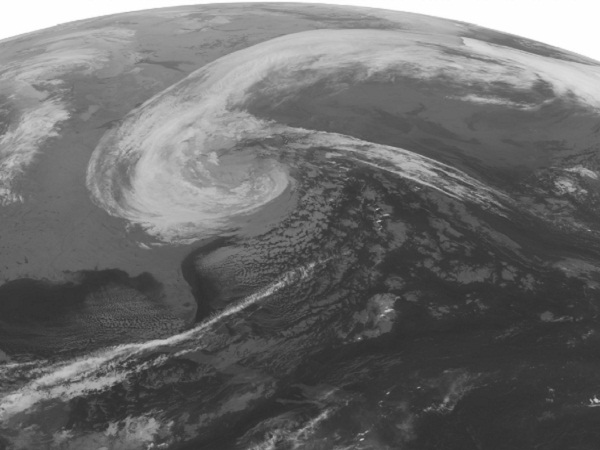`Sandy’ carves path of destruction across eastern US

This NOAA satellite image taken Tuesday, October 30, 2012 at 1:45 a.m. EDT shows Sandy over much of the eastern United States extending from North Carolina to Illinois into the Northeast with areas of rain. Snow is seen over the Central Appalachians and back into Ohio and Michigan. AP/Weather Underground
NEW YORK – Americans awoke to scenes of devastation Tuesday after megastorm “Sandy’’ battered the East Coast, flooding parts of New York City, paralyzing transport and leaving millions without electricity.
The storm weakened as it moved further inland but forecasters still warned of gale-force winds and flooding along the densely-populated coast, where a massive fire broke out in New York City and a levee broke in New Jersey.
At least 13 people were killed in the United States and Canada as the storm roared ashore late Monday, pounding several major cities with heavy rain and hurricane-force winds that toppled trees and ripped down power lines.
President Barack Obama declared a “major disaster” had hit the states of New York and New Jersey, an order that cleared the way for federal grants and loans to help storm victims acquire temporary housing and repair damage.
Seawater coursed between the iconic skyscrapers of New York’s financial district in lower Manhattan, flooding subways and road tunnels and shorting out the power grid, leaving a half-million households and businesses in the dark.
Article continues after this advertisementFurther south, the sea surged over vast swathes of the eastern seaboard, turning coastal cities into ghost towns as the high winds grounded flights and shut down rail links, public transport and government offices.
Article continues after this advertisementThe catastrophe completely overshadowed the US election race, forcing a halt to campaigning a week before Americans were due to go to the polls to choose between President Barack Obama and challenger Mitt Romney.
Hurricane Sandy had killed 67 people as it tore through the Caribbean, and reports of more deaths began to arrive after it made landfall at 8:00 p.m. (8:00 a.m. Manila time) in New Jersey and began to wreak havoc in the United States.
Authorities had ordered hundreds of thousands of residents in areas from New England to North Carolina to evacuate their homes and seek shelter, but many chose to stay on, to the frustration of police and local officials.
Falling trees tore down power cables, plunging what weather experts said were millions of homes into darkness, while storm warnings cut rail links and marooned tens of thousands of travelers at airports across the region.
A nuclear power plant in New Jersey declared an alert as waters rose.
The Oyster Creek nuclear power plant, just north of Atlantic City, New Jersey, was already on a scheduled outage as Sandy made landfall, and the industry regulator said there was no immediate danger.
The hurricane sent a record storm surge of 13.7 feet (4.15 meters) into lower Manhattan, flooding seven major subway tunnels used by hundreds of thousands of daily commuters and swamping cars in the financial district.
“The New York City subway system is 108 years old, but it has never faced a disaster as devastating as what we experienced last night,” city transport director Joseph Lhota said early Tuesday.
Firefighters meanwhile struggled to contain a massive blaze in the Queens borough that destroyed more than 50 homes, and in northern New Jersey police in boats pulled residents from second-story windows after a levee broke.
Hours earlier, a power sub-station exploded in a burst of light captured by amateur photographers as a massive blackout left much of Manhattan, and some 500,000 homes across New York City, in darkness.
The flood waters had begun to recede early Tuesday, but the Con Edison power company said it could take a week to completely restore power.
Disaster estimating firm Eqecat forecast that Sandy would affect more than 60 million Americans, a fifth of the population, and cause up to $20 billion (15 billion euros) in damage.
Refineries closed and major arteries such New York’s Holland Tunnel were shut to traffic. The operator of two major New Jersey nuclear plants said they might have to be closed, threatening half the state’s power supply.
The New York Stock Exchange, the Nasdaq and the futures markets in Chicago were closed for Monday and Tuesday, along with federal government offices and the entire Amtrak rail network on the eastern seaboard.
Obama urged Americans to heed local evacuation orders as he stepped off the campaign trail and spent the day in the White House helping to coordinate the response to the disaster.
“The election will take care of itself next week,” Obama said. “Right now, our number one priority is to make sure that we are saving lives… and that we respond as quickly as possible to get the economy back on track.”
Both the Democratic incumbent and his Republican rival Romney were keen to display resolute leadership in the face of the storm, given the memory of Hurricane Katrina in 2005. Romney also canceled some campaign appearances.
Former president George W. Bush was widely seen as having bungled the handling of Katrina, which devastated New Orleans. The failure of authorities in the ensuing emergency response tainted the rest of his presidency.